Life on the Mekong River
Article and photos by James
Michael Dorsey
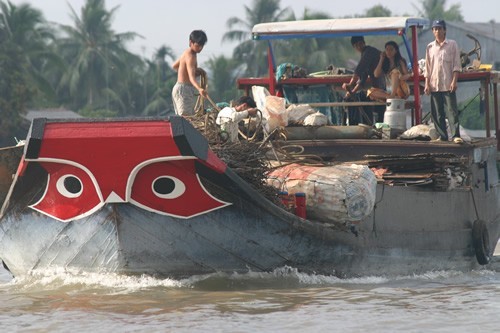
|
|
The Spirit Eyes
floats, with fishnets prepared, on the Mekong River.
|
Spirit eyes, painted on the bow of our boat, appear otherworldly to the children waving at us from the shore through the morning mist. We fade in and out of that velvety haze on Vietnam's Mekong River, cutting through the fog of coal fires and burning trash that hangs like a gauze curtain between the passing jungle and ourselves.
Humidity drapes over us like a blanket, and insects swarm us for salt whenever our boat slows. In a shoreline eddy, whippet-thin fishermen hand-harness nets through the current filled with catfish, and the sunrise, filtered through a thousand coal fires, blurs the jungle's edges as though we are sailing through an impressionist painting. Even while riding the vastness of open water, we are surrounded by the crush of humanity in Southeast Asia.
Mekong is a Western term and a perversion of Mae Nam Khong, loosely translated from its Thai/Lao origin as "Mother of Water." Born on the Tibetan Plateau, its source belches up through a rock spring to gravitate south for 2700 miles (4350 km) through China, Myanmar, Laos, Thailand, and Cambodia before merging its essence with the South China Sea in the marshy delta of southern Vietnam. The Mekong is the main trade route that unites these seven nations in a round-the-clock whirlwind of commerce that words are hard to define. Please think of the world's largest open-air market and social gathering that never stops to catch its breath.
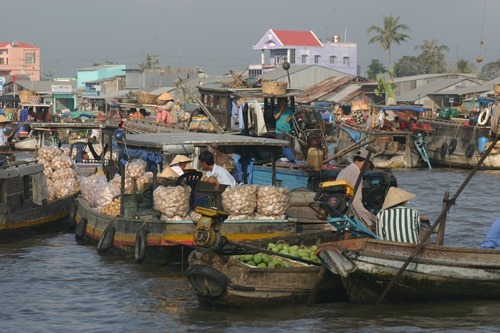
|
|
One of many floating
markets on the Mekong River.
|
Three and four generations of families live together on small boats, venturing ashore only out of necessity. Toddlers learn to swim and walk at the same time. Likewise, they paddle a dugout almost from birth as quickly as they breathe. Dugouts are made without nails, using ancient tongue and groove techniques, and passed down through decades as transport and family heirlooms. Time ceased long ago on the Mekong. There are no watches or clocks to be seen. It is a self-contained water world within a separate reality where a committed visitor may step into the past as far back as they wish. Ho Chi Minh City is Vietnam, but the Mekong remains the Indochina of Joseph Conrad's dark vision.

|
|
Young children paddling in the Mekong River.
|
I met my guide Duc at Can Tho, a rickety series of loading docks rising out of the delta swampland about 50 miles southwest of Ho Chi Minh City. Born and bred on the river, Duc left the old world behind to venture into the vast new one. He only returned to show people like me how people like him live. Duc is one of the Mekong boat people. He has chartered an aging rust bucket straight out of the "African Queen." I question its worthiness to stay afloat until our final stop at Phnom Penh, Cambodia. "Little bit of adventure," he tells me.
No sooner am I onboard than a lovely young girl paddles up to me in a plastic washtub using a palm frond as an oar. "Merican?" she inquires, and when I nod yes, she flashes me the peace sign and paddles away. I did not fight in what is known locally as the "American" war, the final coda of two millenniums of invasions and incursions on this land. Still, I am the age to have done so. My fear of coming to this country is that I will be perceived as a returning enemy. The young girl has done much to allay my fears, and that friendliness will be the norm during my entire stay.
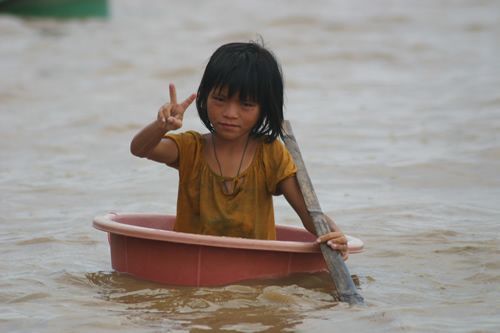
|
|
A very young paddler
floating in a tub on the Mekong River.
|
The docks are a beehive of activity as we motor into the main channel, snaking our way between heavily overloaded large and small commercial vessels. Hundreds of seagulls fall like dive-bombers, taking floating refuse from the water's surface. Some engage in a mid-flight dogfight over large chunks of fish. Families sit cross-legged on sun-bleached decks, eating their morning noodles with chopsticks. Then, they brush their teeth with river water before defecating over the sides with a complete lack of inhibition. Freshly caught fish sizzle on charcoal braziers. While moving at 5 knots on a passing scow, a man dips his dog into the river as a moveable bath. An elderly couple in a tiny dugout is paddling furiously against the current, hauling an immense chest of drawers that could overturn them. If you can fit it on a boat, even if it is larger than the boat, you will see it on the Mekong.
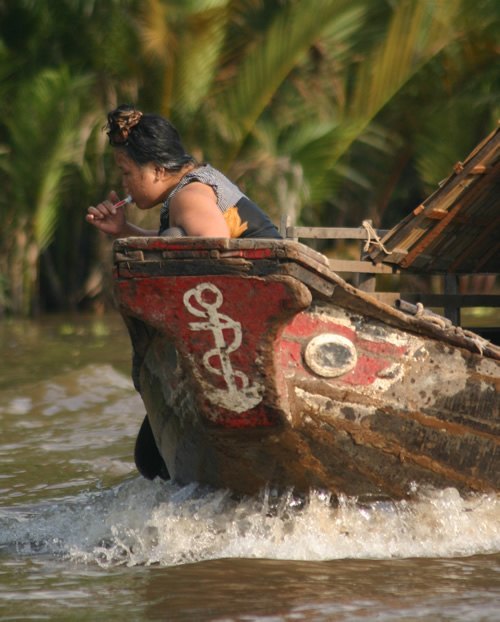
|
|
Brushing teeth while
on the move.
|
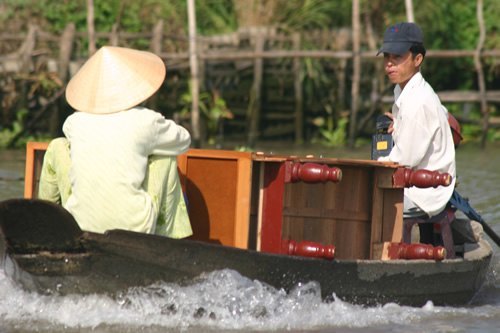
|
|
Carrying a chest of drawers with a tiny dugout on the Mekong River..
|
Neighbors boisterously chat while hopping from deck to deck. Happily screaming children cannonball into the ominous-looking water. Racks of clothing hung on wooden dowels on the rear of boats are outdoor closets, swaying rhythmically with the rocking of the water. A porthole opens, and an older man hacks his morning snuff onto the water and then blows his nose loudly, holding a finger to one nostril. It is a vibrant community getting ready to disperse its commerce in all directions that will reform at each new port of call; one giant family of water gypsies, seemingly interchangeable as chess pieces, that act as a unified whole.
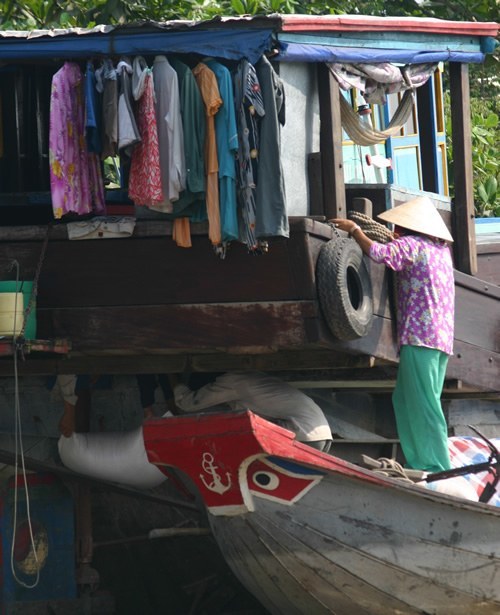
|
|
Family closet on
the Mekong River.
|
We pick up speed with Duc dominating the large wooden tiller, deftly maneuvering us around the countless dugouts. The manned dugouts are everywhere to bring boatmen out to their ships from their palm frond hovels that line the shore. The water is a gray/brown sludge that most would associate with a sewer clog, and it is choked with the detritus of an immense society that drinks, washes, and defecates in it. Yet this river gives life to countless millions and regularly gives up half a ton of catfish to fishermen with the strength to haul them ashore.
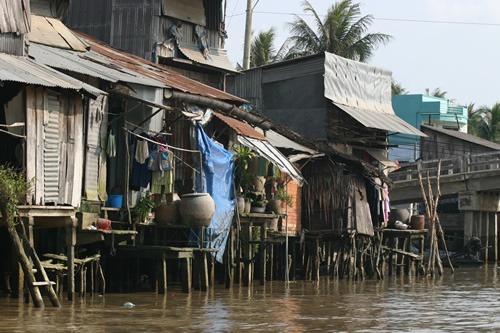
|
|
Mekong River housing.
|
Large woven rattan funnels channel small fish to shoreline eddies, where they are corralled in nets of hand-tied river reeds. Awaiting, the women and children in round conical hats wrestle them onto the muddy bank. In this caste-conscious society, light skin is equated with idle wealth and, thus, beauty. Therefore, women cover up from head to toe, as suntanned skin defines one as a common laborer. With their facemasks, rubber gloves, and knee boots, they bring to mind toxic waste workers. When removing their hats for a second, I notice the flawless, nut-colored skin that seems to have blessed many young Asian women but may betray them quickly as they age. Several motorbikes honk through traffic on the crumbling riverbank ten feet above us. Live pigs larger than the drivers are lashed and struggling to the rear racks on their way to market, squealing not out of fear of death but due to being tied on their backs as no pig wishes to be. Watching five or six of these going down the highway is like a porky pig dance review with all the high kicking.
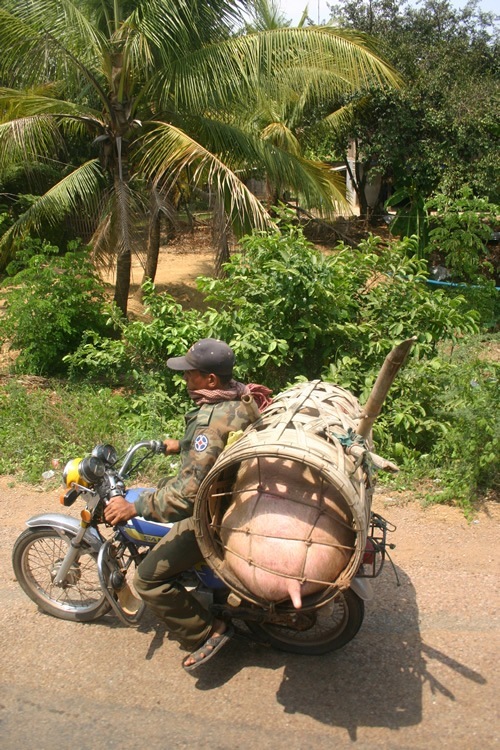
|
|
A huge unhappy pig
on a motorbike.
|
The constant beeping of thousands of motorbike horns jockey for space on tiny dirt trails, their riders all wearing the ubiquitous uniform America has gifted the world: baseball hats and sunglasses, or what seems to be our primary cultural contribution to developing countries after cigarettes and fried chicken. All of this is absorbed by the immensity of the jungle that towers over this giant ballet of life mere yards away. The jungle is a giant primal sentinel of natural growth, standing as a bulwark against the encroachment of modern man. Should the people disappear for only a few days, the aggressive horticultural herd would choke the mighty Mekong into a struggling stream. It is nature co-existing with man, but nature toned down to sub-combat speed out of deference for its inferior planet partner.
We put ashore wherever dusk finds us each night and follow kerosene lamps to simple rooms in the jungle, usually, four concrete walls covered with friendly orange or purple-tinted geckos, a low sleeping futon, and a dinner of rice or vegetables and fish. Dinner goes down with small thimbles of Cobra whiskey, fermented as its name implies with the venom of its namesake, a liquid fire that lasts through the night. Then, Duc would begin to tell his ancient, recent, and personal tales. They all revealed a vibrant culture that can take or leave progress on its own terms. Each night, under the sequined mantle of an indigo sky invisible from beneath the jungle canopy, the cacophony of countless Cicadas, frogs, and endless invisible creatures escalates into a nightly symphony that cradles me peacefully until dawn. Instead, I turn on my headlamp to read and spotlight innocent geckos like escaping cons, freezing them blind on a wall like day-glow refrigerator magnets.
Before we embarked, Duc told me the river would answer all my questions about his country. As we crossed the border into Cambodia, I saw him smiling at me from the bow and sagely nodding his head. He was right. The Mekong is the artery through which a nation's lifeblood flows, and the river revealed to me the essence of Vietnam.
James Michael Dorsey is an explorer, award-winning author, photographer, and lecturer. He has traveled extensively in 45 countries, mostly far off the beaten path. His primary pursuit is visiting remote tribal cultures in Asia and Africa.
|
